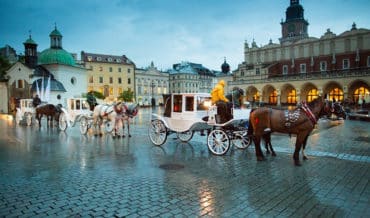Formerly, cloth was made by a clothmaker, who weaved them from wool purchased on the market. As wool has always been popular and desirable, they tried to buy it directly in the countryside and ensure a monopoly on this raw material. Agents began to drive around the area and tried to scavenge the clothiers. The guilds, however, defended themselves against them by forbidding the masters to buy wool from them. The fabric has undergone technical inspection to see if it is woven too rarely or does not contain any errors. When the inspection was successful, the material was referred to the full sheet. Folusznik poured hot water over the square-folded material and placed it under large wooden hammers, which, moved by the force of the water, hammered it. During the filling, the material was able to climb by a third. Now only the materials had to be dyed, combed, finished by cutting, that is, trimming with huge scissors. Postrzygacze usually worked in the town hall, and in Kraków in shearing rooms specially built by King Casimir the Great. They were placed in two-story buildings adjacent to the Cloth Hall. It was also possible to measure cloth in the shearing rooms in Krakow, as this is where the city measure was. The existence of as many as two shearing machines testified to the considerable wealth and affluence of the city.
Suggested
Suggested contents and articles.
Suggested Contents
The suburb of Krakow, lying behind the Vistula Gate, once closing st. Wiślna. In the past, they were called Na Stróży, because in the 16th century there was an office which charged a fee for fish brought through the Vistula Gate to Kraków. Currently, it is the area of Zwierzyniecka
- Knowledge Base
- February 11, 2021
Kazimierz, the current Krakow district, over the years was an independent village. In 1335 King Kazimierz Wielki gave it city rights, and the town was called after him. As the Kazimierz has been developing, there was a necessity to create a place for its government. As a result, in 1414,
- Knowledge Base, Museums
- February 9, 2021
The majestic building in the centre of Krakow’s Main Square – Cloth Hall (Sukiennice in Polish), has stood there for almost seven centuries. It has now become one of the city’s best landmarks. The Cloth Hall has been the heart of the trade in Krakow from city’s very beginning. For centuries it
- Attractions
- October 28, 2016
Contents1 2 Location of the Main Square3 History of the Krakow Main Square3.1 Witness of Polish history4 Landmarks of the Main Square5 The Main Square today The Main Square in Krakow is a large, almost 430,000 ft2 square in the very heart of the historic Old Town. It is one of
- Attractions, Places to visit
- October 25, 2016
Comments
All comments.
Comments

